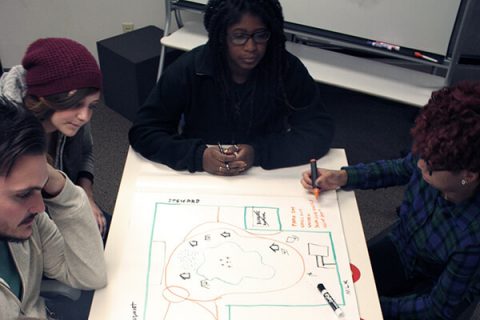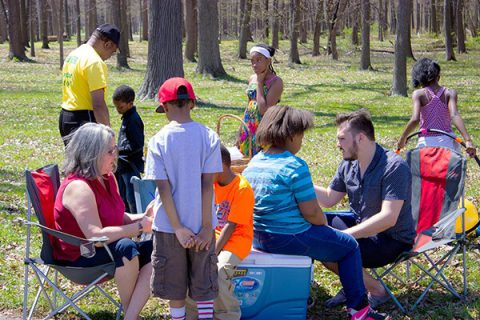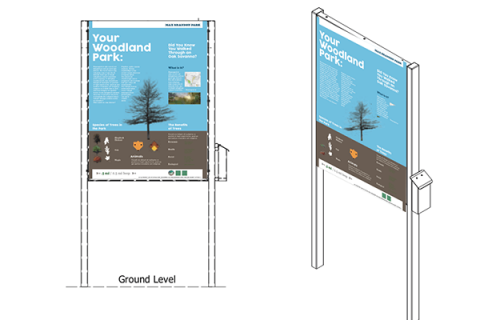UM-Flint Design Students' Work Unveiled in Flint Park

For a group of UM-Flint design students, the path to education included an actual trail in a local urban park.
In September 2015, students from Design Studio began working on the project. Design Studio is a unique course led by Ben Gaydos, Assistant Professor of Design in the Department of Art & Art History at the UM-Flint. Gaydos likes to offer his students real-world opportunities and learning activities involving people in the community. In this class, students gain practical experience working with community partners. The class meets in the University Outreach Innovation Incubator, a creative space that inspires collaboration.

Gaydos learned about Max Brandon Eco Park, a 107-acre urban forest with some trees so large it takes two or three children with outstretched arms to circle the base. It is the second largest open green space in Flint, located at 3606 Dupont Street. Walkers and bicyclists use the space daily. New playground equipment welcomes young families to use the park. A newly restored wetland and boardwalk provide more opportunities to enjoy one of the city's green spaces.
For two semesters, students in Design Studio explored ways to utilize the park's potential. They considered ways to encourage healthy living, promote safety, and teach about the history and ecology of the park. They met with the Friends of Max Brandon Park, who wanted signage along a 1.25 mile trail in the park.

Leyla Sanker, of University Outreach at UM-Flint, shared guidelines for outdoor signage. She also assists K-12 teachers who help their students connect with local surroundings and care about nature. Sanker introduced Design Studio students to curriculum for 4th-8th grade students used in the Discovering Place program. This environmental education model was customized by the Genesee County Parks and Recreation for Max Brandon Eco Park.
The design students took the project seriously. They committed considerable time outside of class to volunteer at park events. They hiked the trail, observed how people use the park, and researched the ecology of the park. In April 2015, they presented their research to city officials and community members. The presentation focused on ways to educate the public on the importance of the park. Lacking funding, the project stalled.

Months later, the City of Flint obtained a Ruth Mott Foundation grant to create signage for the park. Some of the designers volunteered to continue the project, well after classes had finished. The group included Heidi Hals, Nick Looney, and Olivia Johnson. Professor Gaydos and Kurt Neiswender, a local architect and lecturer at UM-Flint, helped guide the process. They met with the City of Flint, the Genesee Conservation District, the Friends of Max Brandon Park, Genesee County Parks and Recreation, and residents who live near the park. They saw the project through to its final stage, committing hundreds of volunteer hours in meetings and design work.
Nick Looney, who has since graduated, said, "You realize you're not getting paid, but by that time we'd done a lot of work on it in school. It became the pet project outside of work and freelance jobs. We met Max Brandon's son, who was really excited by the work. His family members told us the history of the park, which influenced the design."

He said, "What came out of my work with Design Studio and the Max Brandon project is this: Designers tend to go into things thinking 'I know exactly what needs to be done on this design.' That is 100 percent never the case. The way to do it is to go to the community and learn. Collect information, and talk to people. You have to get into other people's shoes if your design is going to be successful."
The trail now guides people though a special place in Flint. Thanks to a generous group of designers, it will be enjoyed by the community for generations to come.
Related Posts
No related photos.
- College of Arts, Sciences & Education
- Community
- Faculty
- Research
- Staff
- University Outreach
- Visual Art
UM-Flint News
The Office of Marketing & Communications can be reached at [email protected].